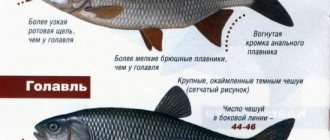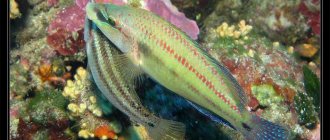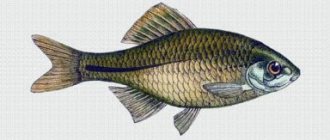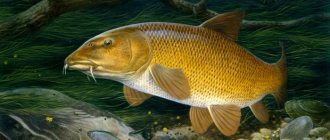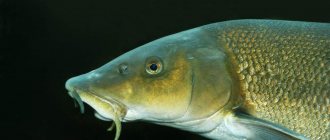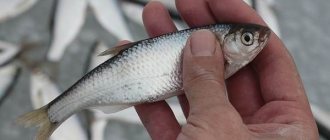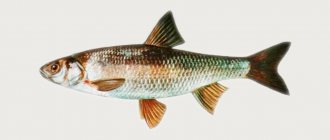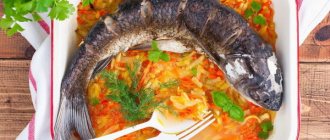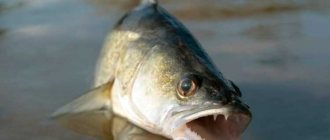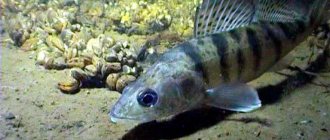- Wild animals
- >>
- Fish
The rudd is a true freshwater predator (albeit a small one) - the fish lives in different rivers and lakes, feeds on even smaller fish, larvae of waterfowl insects, worms, etc. The rudd owes its name to its red fins, although in different places this fish has their own, very specific names. Red-eye, red-winged roach, red-winged roach, magpie, sorog, black-winged roach and many others, even more fanciful. According to modern classification, this fish belongs to the ray-finned class, the cyprinidae family.
Origin of the species and description
Photo: Rudd
The rudd is distinguished by a tall body, flattened on the sides, and a small head. Its teeth are very sharp (this is understandable, since the fish is a predatory fish), sawtooth-shaped and arranged in 2 rows. The scales of the rudd are very large, one might even say dense. In general, the rudd has 37-44 scales on its sides. The maximum body length of the rudd can reach 50 cm, but the fish weighs no more than 2-2.1 kg.
Although in the vast majority of cases, the size and weight of the average rudd is much smaller. This feature is explained by the fact that the rudd is one of the slowest growing fish (in the 1st year of life, its body length increases to only 4.5 mm), so that only adults and even old ones (naturally) can reach the specified maximum size and weight , by fish standards) individuals.
The rudd is distinguished by its bright color; its back is dark brown in color, with a shiny, somewhat greenish tint. In some subspecies it is brown-green. The scales on the belly are shiny and silver in color, and the sides are golden. Naturally, the fins of the rudd, which gave it its name, are bright red. Regarding the appearance of this fish, there is one very interesting point. It lies in the fact that the color of young individuals is not as bright as that of mature and adult rudd. Most likely, this feature is explained by the specific “maturation” of these fish.
Video: Rudd
The lifespan of rudd varies from 10 to 19 years. Regarding species diversity, today it is customary to distinguish several subspecies of rudd, differing not only in the specific appearance, but also preferring different habitats (rudd, in fact, live not only in Russian and European reservoirs - these fish are found almost everywhere).
The species Scardinius erythrophthalmus is a “common rudd” found in many water bodies in Europe and Russia. On average, its body length reaches 25 cm, and its weight is 400 g. It is very rare for it to be more. But despite its small size and natural caution, the fish is popular among amateur fishermen.
Appearance and features
Photo: What does a rudd look like?
Often, even experienced fishermen confuse rudd with a similar and more common fish - roach. This is understandable, because their external similarity is obvious. But despite this, there are several signs by which these two species can be differentiated (even before the prey is cooked and eaten).
So, how does a roach differ from a rudd:
- The body of the rudd is wider and higher - compared to the body of the roach. In addition, the rudd is much less covered with mucus;
- the color of the roach is not so bright and beautiful - the rudd looks much more “spectacular”;
- the rudd's eyes are orange, while the roach's are blood red;
- There are differences in the structure and number of teeth. The roach (herbivorous fish) cannot boast of pointed teeth, and they are located in one row. In the case of the rudd, you can immediately notice 2 rows of sharp and strong teeth, ideal for eating small animals and fish;
- The scales of roach are somewhat larger;
- There is also a difference in species behavior, although a fisherman can only assess it indirectly. The thing is that roach gathers in very large schools, while rudd prefers to settle in “several families.”
How to fry fish. Rudd recipes photos
We have already told you how to fry fish more than once on the pages of our electronic cookbook “Sea Recipes”. But it was mainly sea fish. Today we decided to cook fish that live in rivers and lakes. This fish got its name due to its beautiful appearance - Rudd. More precisely, the rudd is a small-scaled ugai, Sakhalin. Because it is found mainly on Sakhalin.
Rudd is a very tasty fish. But, like all river fish, it is very bony. That is, in its pulp there are many small bones, which can slightly spoil the procedure for satiating you with such a wonderful fish. Don't worry, just watch and read our recipe for today. We will teach you how to solve the problem with small bones. And we’ll tell you a few more interesting points.
You can fry rudd, either freshly caught or freshly frozen. The key word is "fresh". Fresh fish always tastes better.
Where does the rudd live?
Photo: Rudd in the water
As a habitat, rudd chooses areas of water bodies overgrown with algae and reeds, with a slow current or its complete absence. Therefore, the waters of flowing ponds, lakes, as well as quiet river backwaters are ideal options for rudd. No matter how strange it may sound, rudd does not favor fresh water. And the presence of a strong current for her is generally a factor that determines the unsuitability of a reservoir for habitation. Accordingly, it is unlikely that rudd will be caught in mountain, fast rivers - it does not like such reservoirs.
Rudd almost never goes under floating banks - the favorite habitat of tench in any weather. Moreover, the fish never hides (even in the heat) under bushes and roots protruding from the banks. This, by the way, reveals another difference from the roach - even if it is forced to share the same body of water with the rudd, it sticks to much more open places. And it floats, for the most part, close to the bottom. Rudd can often be seen near swimming pools, bridges and rafts - but only if there is no aquatic vegetation nearby.
Regarding the current - yes, the rudd does not like it, but it has nothing against the weak, willingly staying close to the mill whirlpool. This place attracts rudd with an abundance of food. In terms of speed of movement, it is in no way inferior to the roach, and those fishermen who have seen how strongly it splashes, or, more correctly, tumbles, while playing on the water surface, unanimously claim that this splash is made by a much stronger fish than the roach.
Now you know where rudd is found. Let's see what she eats.
How to cook better
Rudd is considered a fish for everyone because it often has a bitter taste. But individuals caught in winter or spring in a clean reservoir, after proper processing, acquire excellent nutritional qualities.
In cooking, rudd is most often used to prepare soft and nutritious fish cutlets. It is also used to make aromatic broths, add boiled white meat to vegetable stews, and stew them in milk. Rudd goes well with potatoes and green peas.
Most often, fish is consumed boiled. But it can also be salted and then used as a snack for alcoholic drinks. It is allowed to fry fish carcasses, although they are first thoroughly washed in a concentrated salt solution to get rid of possible bitterness.
Rudd fish cutlets
The most popular recipe suggests preparing dietary, but tasty and nutritious cutlets from fish carcasses. Ingredients:
- rudd - 1.5 kg;
- lard - 100 g;
- onions - 2 pcs.;
- bread - 1 slice;
- egg - 1 pc.;
- pepper - to taste;
- salt - to taste;
- flour - 100 g.
The step-by-step preparation scheme looks like this:
- Fresh fish is cleaned of scales, gutted and washed from the inside with running water. The fins and head are cut off, and the spine along with large bones are also removed.
- The fish fillets are placed in a clean bowl. The remaining parts are poured with water in a saucepan and broth is made from them, which will be needed in the process of preparing the cutlets later.
- Fish fillets are ground in a meat grinder. At the same time, lard and onions are chopped, and the bread is pre-soaked in milk, squeezed out and kneaded into a paste.
- Minced fish is combined with prepared ingredients and an egg and spices are added. The ingredients are thoroughly mixed and small cutlets are formed from the resulting mass.
- The pieces are rolled in flour and fried in vegetable oil without covering with a lid. After the golden crust appears, pour about 2/3 of the fish broth into the frying pan and close the container, and then simmer the rudd over low heat for another ten minutes.
Recommended reading: Benefits of lamb
The finished cutlets are served immediately. You can combine them with vegetable dishes and herbs.
Attention! After cleaning, small bones may remain in the rudd, but this is not a problem - during the processing they will steam and become soft and safe.
Rudd cutlets do not lead to weight gain, but help maintain muscle tone
What does the rudd eat?
Photo: Rudd fish
In terms of diet, the rudd is completely unpretentious, despite the fact that it is a typical predator.
In fact, this fish is omnivorous and eats almost everything it can:
- various larvae of aquatic insects and the insects themselves;
- worms;
- freshwater caviar;
- plant food, namely: algae, plankton and young shoots of aquatic plants.
There is one important feature in terms of diet - young rudd consume exclusively zooplankton. And only at the onset of sexual maturity do they switch to “omnivory”, consuming more varied food. The food of adult rudd, in addition to all of the above, is represented by young shoots of aquatic plants and filamentous algae. She does not disdain the caviar of other fish, and she also eats young fish with pleasure.
In the summer, rudds very willingly consume snail eggs, which they lay on the back of the leaves of water lilies (meaning on the one that faces the water). So, when you go fishing on a wonderful June evening, you can hear a ubiquitous loud smacking sound in the thickets of water lilies - these are rudds intensively cleaning off the slimy eggs of snails stuck to the leaves of water lilies, thus intensively reducing the population of the latter. A caught rudd makes a similar sound in the air.
Fishing places and habitat
The Sakhalin ugai rudd has the narrowest range of all Far Eastern rudd. In addition to Sakhalin, the fish is distributed on some small islands along the Pacific coast, as well as Hokkaido, northern Honshu, Iturup and Green Island. In stagnant reservoirs and bays, the fish prefers to stick to possible shelters in the form of vegetation or bottom irregularities. On rivers, anglers prefer to look for fish near the rifts and boundaries of the sandy and muddy bottom. They are caught both with and without bait.
Features of character and lifestyle
Photo: Common rudd
By mid-late September, young rudd en masse move into the reeds and, most likely, spend the winter there. Adults, sexually mature individuals, at this time, prefer to stay in deeper places. Rudds try to appear less and less often at the surface of the water. As a result, they go to bed for the winter in October. In short, starting from mid-October you can’t even hope to catch a rudd. At least, you definitely won’t be able to do this with a regular float rod.
In ponds and lakes, as well as in small rivers, in winter, when oxygen becomes insufficient, rudd floats closer to the surface. At this time it can be caught in large quantities. Although it should be noted that rudd is a very hardy fish. It is almost as unpretentious to water quality as tench, and is much stronger and more tenacious than ordinary roach.
The significant population size of the common rudd is due to the fact that catching this fish is associated with significant difficulties - it is very difficult to catch, because the rudd shows increased caution. The fish rarely appears in open spaces, and if there is danger, it immediately hides in thickets of aquatic vegetation - this feature is more difficult for natural enemies. But fishermen pay attention to the fact that catching rudd can only happen with bright yellow bait. A peculiarity of this fish is its complete disregard for baits of other colors.
Interesting fact: Rudd (all its subspecies) have not acquired industrial importance. The reason is the somewhat bitter taste. But for sport fishermen it is of great interest - mainly due to its wide habitat and difficulty of catching. Rudd is not caught to make fish soup from it - the process of catching itself is important to fishermen.
Where and how to catch
There are several special signs for choosing a fishing spot
So, what you should pay attention to:
- The purity of the water in the reservoir. The fastidious beauty does not like dirty ponds.
- Visual presence of representatives of this fish in the upper layers of the studied reservoir.
- The presence of a large amount of aquatic vegetation.
- No flow. She doesn't like fast water.
- The water should warm up well, so you should not look for rudd in deep and shaded holes.
Having decided on a place, you need to think about gear and bait. The best fishing gear will be a float rod. It is best to choose a fishing line that is strong but thin so that it is invisible in clear water. Strength is needed to cope with snags on vegetation, because you will have to fish in close proximity to thickets of water lilies or right among them.
Since the lake fashionista is not particularly picky when it comes to food, you can catch it with both plant and animal bait. Large rudd are easy to catch with a small spinner. The lake beauty has an excellent sense of smell, so it doesn’t hurt to use aromatic additives and special baits to lure the cautious sorceress out of the thickets and into the open.
She will gladly forget about caution when she smells the fragrant bait
Rudd is actively caught almost throughout the warm season. You should try different baits throughout your fishing trip. This can be a dough with anise oil or honey. Black or white bread. Earthworms are one of the rudd's favorite delicacies. Maggots, flies, grasshoppers and dragonflies can all make excellent bait. Steamed peas and wheat also often attract large representatives of this species.
No fisherman will be disappointed when he catches a beautiful inhabitant of picturesque lakes and quiet rivers. The experience gained from an unforgettable adventure will help in future trips for a larger catch.
Social structure and reproduction
Photo: Rudd
At 3-5 years of life, the rudd reaches sexual maturity. By this time its size is already about 11-12 cm in length, and the fish is ready for spawning. The duration of this process is 2-3 months, from April or May (the beginning depends on the habitat) until the end of June. Please note that this period is relevant if the average temperature is 16-20 degrees. At the start of spawning, the color of rudd becomes much brighter and more expressive than at all other times.
Fish eggs are deposited on aquatic plants, and the rudd do not release them all at once, but in strictly measured doses. Another feature of these fish is that before the moment of reproduction, 2 portions of eggs already mature, and the 3rd is formed right at the moment of spawning. The eggs themselves are sticky and measure 1-1.5 mm in diameter. On average, rudd lays up to 232 thousand eggs, but it is very difficult for those who like to profit from unborn fry to find them (the eggs are usually attached to the roots of aquatic plants, and rudds camouflage them really skillfully).
The duration of the incubation period does not exceed 3 days. When the fry hatch, their length is 5 mm, and upon reaching 30 mm, a specific fry period begins. The size of the rudd population is limited by the fact that many potential fry die during the incubation period, becoming the “breakfast” of small predators.
Interesting fact: The large population of rudd is also explained by the fact that, under certain circumstances, they can mate with other representatives of fish belonging to the carp family. Therefore, hybrids of rudd with crucian carp, tench, bream, and even more so with roach are possible. Moreover, what is most interesting is that, contrary to the laws of genetics, the hybrids resulting from such crossing do not lose their ability to reproduce and successfully produce fertile offspring. This feature serves as another condition contributing to the rapid growth of the common rudd population.
Fishing methods
Rudd is a fish (photo below) that is extremely intelligent.
For catching it, a floating bait is ideal, which should be slowly submerged to the very bottom and removed from the water in the same way. If the depth of the reservoir where you are fishing is no more than three meters, it is better to use a movable float. At the same time, she will eat the bait only after she is convinced that it does not pose a threat to her.
It is worth considering that the bite will be much more intense if the rudd living in the reservoir of your choice have grown to 20 cm in length.
If the fish reacts to the bait, the float will sharply go under the water and immediately move to the side. In this case, a large rudd will first make several test twitches, and only after making sure that it does not pose a danger to its life will it grab the bait. In addition, keep in mind that when the bait is slowly moved under water, even the bream living nearby can react to it.
The hook should be quick and short. This is due to the fact that the lips of a rudd are quite delicate, and if you do not have time to remove it from the water, it may simply jump off the hook. In addition, this fish puts a lot of effort into freeing itself.
Natural enemies of rudd
Photo: What does a rudd look like?
Due to the large population, the common rudd very often becomes a delicacy for such freshwater predators as pike, catfish and perch - large fish have learned to overcome all its “tricks”. In principle, it is the presence of natural enemies that is the main factor restraining the growth of the rudd population - in this way it is possible to maintain balance in the ecosystem of reservoirs, because the “red roach” breeds in significant quantities.
Accordingly, in the absence of restraining factors, the fish will acquire the status of trash. Crucian carp do not dare to attack sexually mature rudd; it is problematic for them to find caviar (the latter hide it too well), but it is easy to feast on young animals. Another enemy of the rudd is considered to be snails - small and large pond snails. Let's just say they reciprocate by destroying the eggs.
However, the main enemy of the red roach remains man - and not an ordinary fisherman with a fishing rod, or even a poacher with a net. The growth of the population of these fish is so rapid that no matter how hard you try, they cannot be exterminated. But industrial emissions from enterprises cause irreparable damage to the rudd. But even this problem, rudds have learned to cope - after the release of harmful substances, they migrate en masse upstream, and then return. The harm from chemical emissions for other fish species is much more destructive.
